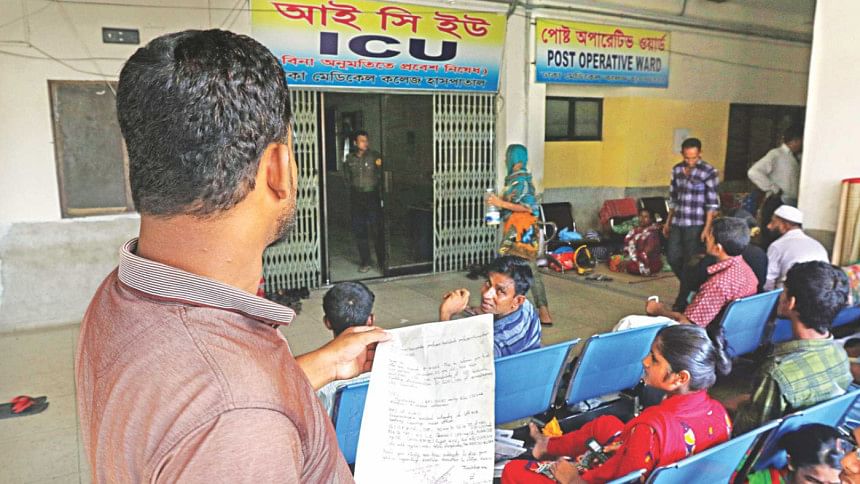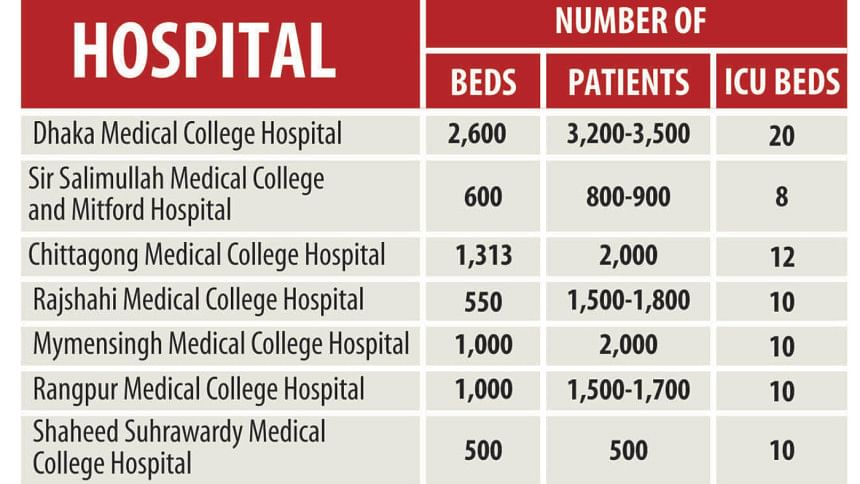ICU facilities scanty

Seventy-year-old Lal Mia Matabbar was rushed to Faridpur Medical College Hospital when he suffered a major stroke on September 2 morning.
On doctors' advice, he was taken to Dhaka Medical College Hospital the same day. Stating his condition critical, doctors at the DMCH suggested transferring him to intensive care unit (ICU) as early as possible.
His son Qaiyum Matabbar ran to the ICU but found no bed vacant. The authorities, however, put his father's name on the waiting list.
Over the next five days, Qaiyum and his elder brother Iqbal went to the ICU for 20 to 25 times. "We met the hospital director and even tried to get recommendations from government high officials to pursue ICU authorities. But nothing worked," said Qaiyum.
"We couldn't afford the costly ICU services of private hospitals either," he added.
Lal Mia died on the morning of September 7.
Every day, majority of patients seeking ICU services in government general hospitals are denied admission due to scarcity of beds in those units.
Only seven government general hospitals have ICU facilities with 80 beds in total, Prof Md Shamiul Islam Sady, director (hospital and clinics) of Directorate General of Health Services (DGHS) told The Daily Star recently.
Three of the hospitals are in Dhaka and the four in Chittagong, Rajshahi, Rangpur and Mymensingh.
There is no data centrally about patients seeking treatment at those ICUs every month though each hospital keeps record individually.
According to Abdur Rahman, who is in-charge of ICU at the DMCH, around a dozen patients come to the unit every day but only one or two can get admitted at best.
Some 32 patients sought ICU services at the hospital in the first three days of this month but the authorities could accept only one of them. Last month, 406 people tried to get admitted to the unit but only 74 could be accommodated.
"Denying admission to a patient [who needs to be at ICU] is very painful and embarrassing but our hands are tied," said Abdur Rahman, also head of anaesthesia department at the hospital.
Patients with neurological and respiratory problems and life-threatening illnesses and injuries need ICU as they require constant, close monitoring and support of special equipment and medications.
As per the international standards, in a hospital the ratio between the total number of beds and the beds in its ICU should be 20:1, meaning a 100-bed hospital should have at least five ICU beds.
There are about 2,600 beds at the DMCH where 3,200 to 3,500 patients take treatment regularly.
The number of beds at the ICU is too insufficient against the demand, said Abdur Rahman. So, they have set priorities for admitting patients to the unit.
Their first priority, he explained, is critically ill patients from the hospital's operation theatre and post-operative ward and then those from different sections.
He, however, hoped another 12-bed ICU will come into operation within this fiscal year.
The hospital has a 35-bed ICU exclusively for neonatal care unit and a 10-bed ICU for burn patients, sources said.
ICU services are also available at several state-run specialised hospitals, including National Institute of Cardiovascular Diseases, National Institute of Chest Disease & Hospital and National Institute of Neurosciences & Hospital. But the units together have only 111 beds, said a deputy director of DGHS.
ICU services in private hospitals are too costly as they charge Tk 15,000 to Tk 1,00,000 a day.
There is even example that a middle-income family had to sell land or other property to pay the bills of ICU at a private hospital. Their patient went to the hospital finding no bed at government ICUs.
On the other hand, government hospitals provide ICU services for a nominal charge.
But they have inadequate seats because, authorities say, such a unit is very expensive and difficult to maintain and it requires involvement of a lot of people.
Mymensingh Medical College Hospital Director Brig Gen Md Fashiur Rahman told The Daily Star that the 10-bed ICU was set up around seven or eight months ago. There was a four-bed ICU, which was declared abandoned, he added.
"It's not enough at all," said the director, adding they were working to increase the number to 20. "Even if a 20-bed unit is set up, it will remain filled with patients every day."
Rangpur Medical College Hospital Director Prof Md Barkatullah also said a good number of patients seek admission to their 10-bed ICU regularly but they cannot admit majority of them due to scarcity of the seats.
Prof Rashid-e-Mahbub, ex-president of Bangladesh Medical Association, said at least 1 percent of beds at a government hospital should be with ICU facilities.
Khalilur Rahman, former ICU chief at DMCH, said some doctors refer their patients to ICUs to avoid responsibilities. The ICU remains filled with such patients, depriving those who really need it.
There is also allegation that getting admitted to ICU at a government hospital is hardly possible if patients don't have connections.
However, Prof Md Shamiul Islam of the DGHS said the number of ICUs is being increased gradually.
In the first phase, ICUs were set up in eight general hospitals. Except for Sher-e-Bangla Medical College in Barisal, all the hospitals are providing ICU facilities. The ICU in the Barisal hospital will start operating soon.
In the second phase, a 10-bed ICU will be set up in each of the five other hospitals -- Dinajpur Medical College Hospital, Cox's Bazar Medical College Hospital, Noakhali Abdul Malek Ukil Medical College Hospital, Khulna Medical College Hospital and Comilla Medical College Hospital.

Equipment for ICUs for these hospitals has already been purchased and other procedures like recruiting manpower are going on, said Prof Shamiul. He could not give any deadline.
In Bangladesh, there are 483 primary healthcare centres run by the DGHS at the upazila level and below, with 19,855 beds, according to government Health Bulletin-2014.
There are 126 hospitals with 28,978 beds under the DGHS at the district level and above, it said.
However, the number of regular patients is far more than the numbers of beds in these hospitals.

 For all latest news, follow The Daily Star's Google News channel.
For all latest news, follow The Daily Star's Google News channel. 



Comments